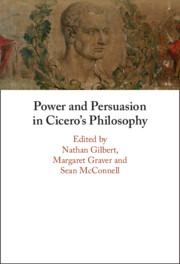Book contents
- Power and Persuasion in Cicero’s Philosophy
- Power and Persuasion in Cicero’s Philosophy
- Copyright page
- Contents
- Contributors
- Note on Texts and Translations
- Introduction
- Part I Techniques and Tactics of Ciceronian Philosophy
- Chapter 1 Cicero on Rhetoric and Dialectic
- Chapter 2 Cicero’s Platonic Dialogues
- Chapter 3 Mos dialogorum
- Chapter 4 Nos in diem vivimus
- Chapter 5 Cicero the Philosopher at Work
- Part II Political Philosophy and Ethics
- References
- Index Locorum
- General Index
Chapter 3 - Mos dialogorum
Scepticism and Fiction in Cicero’s Academica
from Part I - Techniques and Tactics of Ciceronian Philosophy
Published online by Cambridge University Press: 15 January 2023
- Power and Persuasion in Cicero’s Philosophy
- Power and Persuasion in Cicero’s Philosophy
- Copyright page
- Contents
- Contributors
- Note on Texts and Translations
- Introduction
- Part I Techniques and Tactics of Ciceronian Philosophy
- Chapter 1 Cicero on Rhetoric and Dialectic
- Chapter 2 Cicero’s Platonic Dialogues
- Chapter 3 Mos dialogorum
- Chapter 4 Nos in diem vivimus
- Chapter 5 Cicero the Philosopher at Work
- Part II Political Philosophy and Ethics
- References
- Index Locorum
- General Index
Summary
This chapter focuses on the ways in which Cicero’s choice of dialogue form serves to support his preferred position of Academic Scepticism in the Academica. From the letters Cicero wrote to Atticus while composing this work, we know that he was particularly interested in the verisimilitude of the conversation presented in his text. Yet, in the dedicatory letter that accompanied this text, Cicero is at pains to point out that this conversation is, in fact, fictitious, presenting to the reader speeches that never took place. The contention of this chapter is that Cicero’s apparently paradoxical focus on both the credibility and the fictitious nature of his dialogue can be explained by the epistemological stance advocated in this text. By creating a dramatically convincing (in rhetorical terms, enargēs, or ‘evident’) account of a conversation that never took place, Cicero is providing his reader with a further counter example to the Stoic theory of the kataleptic impression, which holds that true impressions can be distinguished from false impressions by virtue of their unique enargeia (or ‘evidentness’). Consequently, then, the form of the dialogue itself serves to reinforce the Academic claim that we have access to no clear criterion of truth.
Keywords
- Type
- Chapter
- Information
- Power and Persuasion in Cicero's Philosophy , pp. 52 - 76Publisher: Cambridge University PressPrint publication year: 2023

